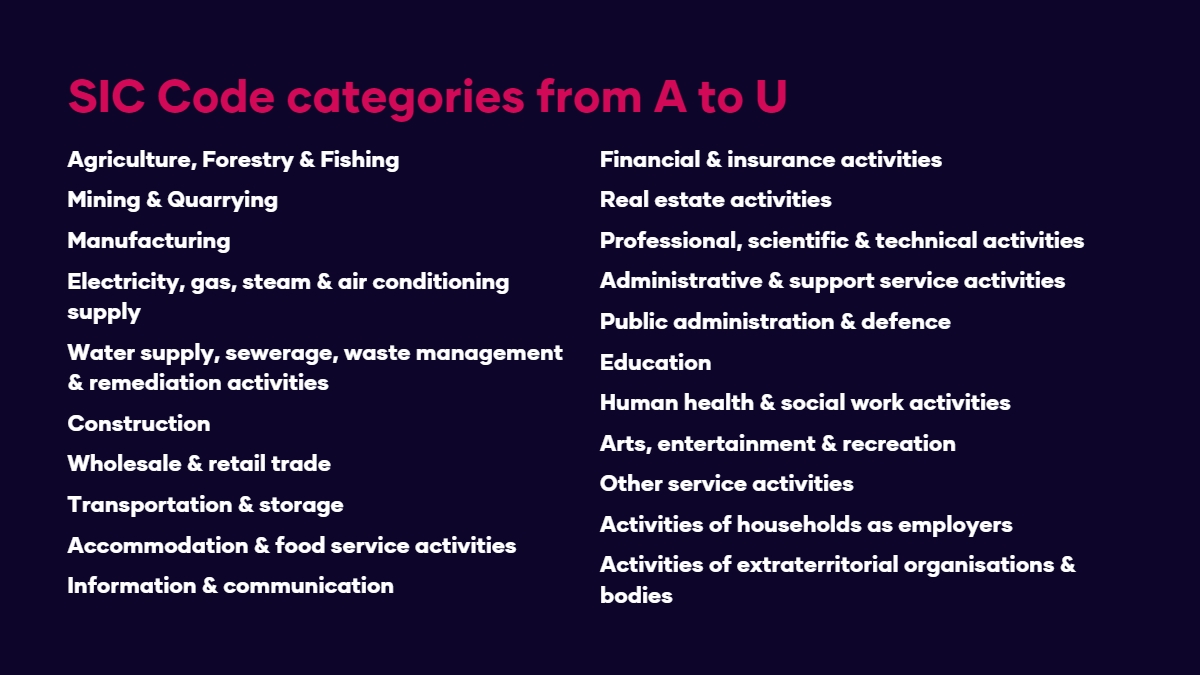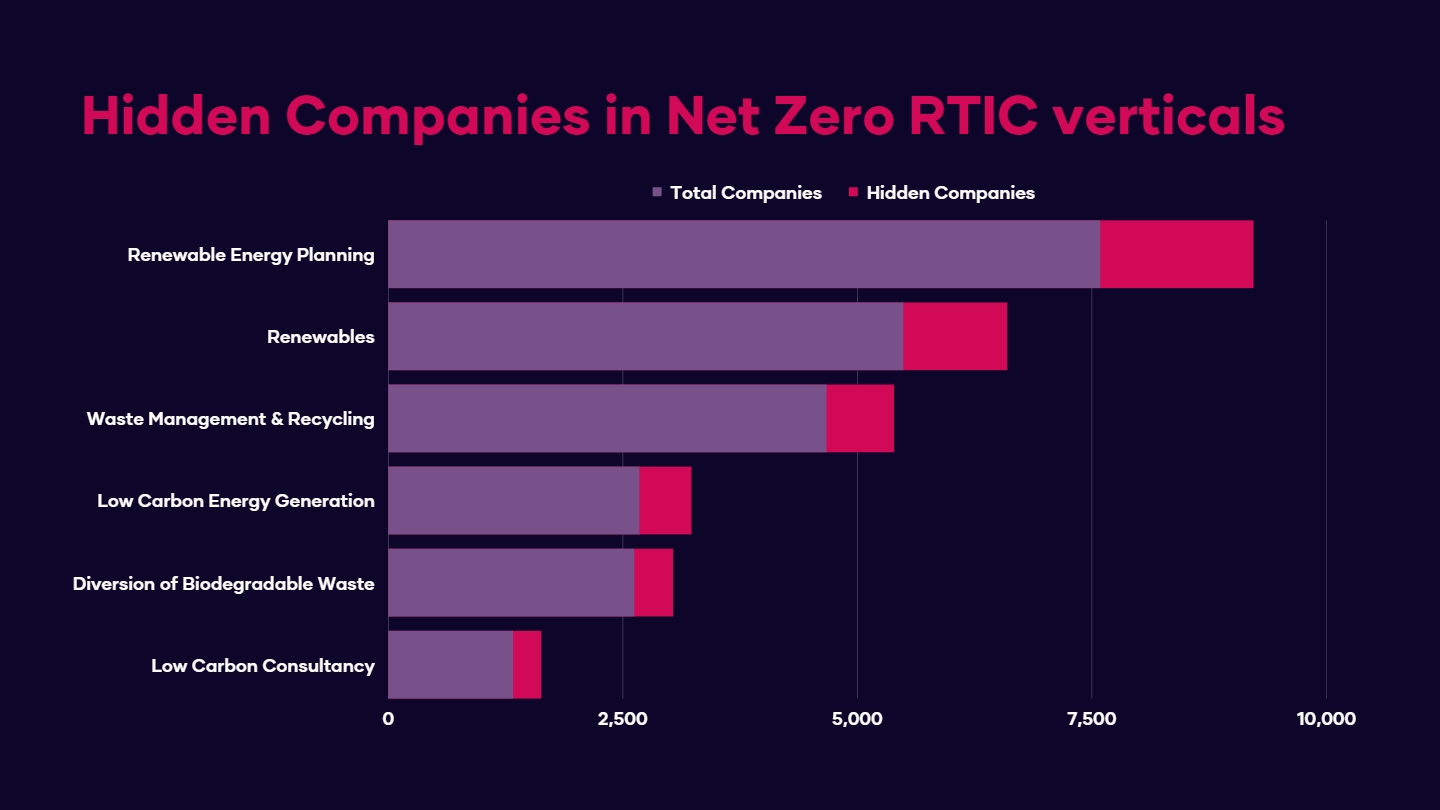The Standard Industrial Classification (SIC) system was designed to help classify businesses and provide insight into economic activity and industries in the UK. But did you know that almost three quarters of a million UK companies haven’t been properly classified? In this article we take a closer look at the UK’s hidden economy and the companies left in the dark by the SIC code system.
So what is a SIC code?
A Standard Industrial Classification (SIC) code is a five-digit code that’s used to classify a business’ main area of economic activity or in short, what they do. When a company or business is incorporated, you must choose at least one SIC code, however in some cases you can choose as many as four.
SIC codes are broken down by category, with 21 (from A to U) main sections to choose from. These are broader industries such as Manufacturing (Section C), Construction (Section F) and Education (Section P) which are made up of several subcategories or codes. For example, Construction is made up of 25 SIC codes, which includes activities like Demolition (43110), Plastering (43310) and Glazing (43342).

With a total over 700 SIC codes, ranging from the mundane (64192 Building societies, 69203 Bookkeeping activities) to the more obscure (20510 Manufacture of explosives, 01230 Growing of tobacco) – the idea of this extensive segmented SIC code system is to capture the full breadth of the UK economy and give business owners the best possible chance to accurately classify their company.
However, with the SIC code system last updated fifteen years ago in 2007 and the complicated self-classification process causing issues for business owners and companies that change over time, SIC codes are becoming increasingly defunct.
N.E.C. (Not Elsewhere Classified)
For more traditional companies, the SIC Classification system can work well to capture who they are and what they do. But with the development of new technologies and industries over the past fifteen years, SIC codes make it difficult to accurately map and understand the UK’s emerging economies.
We’ve spoken before about the issues surrounding SIC Codes, particularly looking at the use of ‘other’ codes for many new businesses that aren’t represented in the 2007 list. Our research shows that one third of all UK companies were listed in an ‘other’ or n.e.c. SIC code, meaning a huge amount of the UK’s company base may not be represented as they should.
SIC’s n.e.c. codes provide a particular problem for accurate classification and in turn make the mapping of many emerging sectors such as FinTech, the Net Zero ecosystem and Advanced Manufacturing very difficult.
| SIC Code | SIC Description | # of companies |
|---|---|---|
| 82990 | Other business support service activities n.e.c. | 249,233 |
| 96090 | Other service activities n.e.c. | 162,888 |
| 74909 | Other professional, scientific and technical activities n.e.c. | 83,693 |
| 64209 | Activities of other holding companies n.e.c. | 68,595 |
| 43999 | Other specialised construction activities n.e.c. | 64,272 |
| 85590 | Other education n.e.c. | 47,328 |
| 63990 | Other information service activities n.e.c. | 28,409 |
| 32990 | Other manufacturing n.e.c. | 22,181 |
| 42990 | Construction of other civil engineering projects n.e.c. | 20,921 |
| 93290 | Other amusement and recreation activities n.e.c. | 20,874 |
There are currently 38 ‘Not Elsewhere Classified’ (or n.e.c.) codes used across the 21 sections of the SIC database with 886,106 distinct companies (one in every five in the UK) that are currently classified using one. These 38 codes are typically very broad, catch-all categories that range from business support and information services to construction and other manufacturing activities.
The UK’s hidden economy
Using the Standard Industrial Classification system, there are currently around 740,000 companies in the UK that are ‘Hidden’. These are companies that are only classified under n.e.c. codes, and don’t use other standard codes alongside to describe their economic activities.
Whilst we might be able to see what broad industry these hidden companies work in, these codes provide very little value when it comes to actually measuring UK growth or emerging sectors. N.e.c. codes act as a dumping ground for companies within emerging markets which aren’t represented in the 2007 database, meaning thousands of businesses, millions of employees and billions in turnover often remain hidden or wrongly attributed in economic reports or policy development using SIC codes alone.
Using the Standard Industrial Classification system, there are currently around 740,000 companies in the UK that are ‘Hidden’.
And it’s not just those in FinTech, Immersive Technologies and other emerging sectors that are being tracked incorrectly. It might surprise you to see some of the UK’s largest and most well-established companies are to be found in the n.e.c. lists. Bupa Finance, NatWest Bank, Currys and even parts of Royal Mail are currently classified using a hidden SIC code.
So how do we go about representing the UK’s hidden economy of n.e.c. companies? Well, at The Data City, we think the first step to understanding the UK’s emerging economy is to use real-time data. With the pace of the growth of the UK’s industries, it’s vital that classification reflects what’s happening in the real world. That’s where Real-Time Industrial Classifications (RTICs) come in.
Using RTICs to map the UK’s hidden companies
Developed by our data experts and in association with the UK’s leading ministerial departments and organisations, we’ve published over 350 industry sectors and verticals to date, mapping growing sectors such as Net Zero, AgriTech, Artificial Intelligence, the Space Economy and much more.
Created using a combination of Machine Learning (ML) and ‘expert-in-the-loop’ training we let company websites tell us what companies do, meaning our classifications are self-updating and always keeping pace with the innovation driving the sector. This means companies previously hidden in n.e.c. SIC codes have a better chance of being classified in our up-to-date database.
From our research we know that 36% of companies hidden in n.e.c. codes are now matched on our platform with many classified across 47 of our 49 RTICs and 345 of our verticals. Looking into our RTIC data we know that for 16 of our RTICs, more than 20% of each is made up of hidden n.e.c. companies. From this we know that certain emerging sectors are not being represented in the SIC code system.

For example, did you know that almost 20% of our Net Zero RTIC is made up of hidden companies? There are almost 6,000 companies that have been poorly classified in the SIC code system as 82990 Other business support service activities n.e.c., 64209 Activities of other holding companies n.e.c. and over eight other hidden codes. Looking closer at verticals within the Net Zero ecosystem we know that renewables, waste management, low carbon energy generation and diversion of biodegradable waste from landfill are the most poorly defined by SIC codes.
We can also see other examples of where hidden companies make up a large percentage of our RTICs. Over 28% of the UK’s Modular Construction industry is made up of hidden companies and one in four companies in our Advanced Manufacturing RTIC is classified in the SIC system as an n.e.c. code.
In the below table you can see the number of hidden companies included in our RTICs:
| RTIC code | RTIC name | Hidden companies | Total companies | % |
|---|---|---|---|---|
| RTIC0063 | Modular Construction | 383 | 1,360 | 28% |
| RTIC0076 | Legal Services | 3,910 | 15,566 | 25% |
| RTIC0065 | Advanced Manufacturing | 3,835 | 15,583 | 25% |
| RTIC0034 | Advanced Materials | 619 | 2,611 | 24% |
| RTIC0008 | Geospatial Economy | 799 | 3,420 | 23% |
| RTIC0047 | CleanTech | 1,248 | 5,385 | 23% |
| RTIC0026 | Omics | 206 | 890 | 23% |
| RTIC0051 | Quantum Economy | 140 | 612 | 23% |
| RTIC0075 | Land Remediation | 605 | 2,666 | 23% |
| RTIC0068 | Media and Publishing | 2,695 | 12,027 | 22% |
What does this all mean?
As the SIC system hasn’t been updated since 2007 and with no signs it will be updated in the next few years (the most recent estimate shows an update in 2025, but this has been delayed several times already) it has never been more important to rely on real-time data to classify the UK’s emerging sectors. And the solution is easy enough moving forward. Simply agreeing on a new standard of industrial classification, using real-time data will allow us to map, analyse and understand the UK economy.
Our platform allows public sector organisations, consultants, governing bodies and more to break free from the chains of the outdated SIC system and map growing sectors faster, for less money and with better accuracy.
We’ve mapped 350 sector verticals to date using our innovative ML-powered platform, but there’s always more to do and new industries to discover. If you have a particular project in mind or need help classifying a specific sector, we’d love to hear from you. Simply get in touch today and we’ll be in touch.
Article researched by Amanda Otley and written by Andy Crowder.


